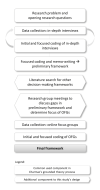Decision-making on maternal pertussis vaccination among women in a vaccine-hesitant religious group: Stages and needs
- PMID: 33180859
- PMCID: PMC7660565
- DOI: 10.1371/journal.pone.0242261
Decision-making on maternal pertussis vaccination among women in a vaccine-hesitant religious group: Stages and needs
Abstract
Introduction: As of December 2019, pregnant women in the Netherlands are offered pertussis vaccination to protect their newborn infant against pertussis infection. However, the manner in which pregnant women decide about this maternal pertussis vaccination is largely unknown. The aim of this study is to gain insight into the decision-making process regarding maternal pertussis vaccination, and to explore the related needs among the vaccine-hesitant subgroup of orthodox Protestant women.
Methods: Charmaz's grounded theory approach was used to develop a decision-making framework. To construct this framework we used an explorative multimethod approach in which in-depth interviews and online focus groups were supplemented by a literature search and research group meetings. This study was carried out in a hypothetical situation since the maternal pertussis vaccination had yet to be implemented in the Dutch immunisation programme at the time of the study.
Results: Twenty-five orthodox Protestant women participated in an interview, an online focus group, or in both. The findings of this study resulted in a decision-making framework that included three stages of decision-making; an Orientation stage, a value-based Deliberation stage, and Final decision stage. The Orientation stage included the needs for decision-making categorised into Information needs and Conversation needs. Women indicated that -if they were to receive sufficient time for Orientation and Deliberation- they would be able to reach the stage of Final decision.
Conclusion: The decision-making framework resulting from our findings can be used by health care professionals to provide women with information and consultation in the decision-making process. Future studies should investigate whether the stages of and needs for decision-making can be found across other vaccine-hesitant subgroups and vaccinations.
Conflict of interest statement
The authors have declared that no competing interests exist.
Figures
Similar articles
-
Insights into maternal pertussis vaccination counselling: a qualitative study on perspectives and experiences among midwives and gynaecologists in the Netherlands.BMC Infect Dis. 2024 Sep 2;24(1):903. doi: 10.1186/s12879-024-09681-7. BMC Infect Dis. 2024. PMID: 39223488 Free PMC article.
-
Vaccine decision-making begins in pregnancy: Correlation between vaccine concerns, intentions and maternal vaccination with subsequent childhood vaccine uptake.Vaccine. 2018 Oct 22;36(44):6473-6479. doi: 10.1016/j.vaccine.2017.08.003. Epub 2017 Aug 12. Vaccine. 2018. PMID: 28811050
-
Influenza and pertussis vaccination in pregnancy: Portrayal in online media articles and perceptions of pregnant women and healthcare professionals.Vaccine. 2018 Nov 29;36(50):7625-7631. doi: 10.1016/j.vaccine.2018.10.092. Epub 2018 Nov 3. Vaccine. 2018. PMID: 30401620 Free PMC article.
-
Experience and challenges on influenza and pertussis vaccination in pregnant women.Hum Vaccin Immunother. 2018;14(9):2183-2188. doi: 10.1080/21645515.2018.1483810. Epub 2018 Jul 24. Hum Vaccin Immunother. 2018. PMID: 30024822 Free PMC article. Review.
-
Influenza and pertussis vaccine coverage in pregnancy in Australia, 2016-2021.Med J Aust. 2023 Jun 19;218(11):528-541. doi: 10.5694/mja2.51989. Epub 2023 May 29. Med J Aust. 2023. PMID: 37248802 Review.
Cited by
-
Insights into maternal pertussis vaccination counselling: a qualitative study on perspectives and experiences among midwives and gynaecologists in the Netherlands.BMC Infect Dis. 2024 Sep 2;24(1):903. doi: 10.1186/s12879-024-09681-7. BMC Infect Dis. 2024. PMID: 39223488 Free PMC article.
-
Decision-making on COVID-19 vaccination: A qualitative study among health care and social workers caring for vulnerable individuals.SSM Qual Res Health. 2022 Dec;2:100181. doi: 10.1016/j.ssmqr.2022.100181. Epub 2022 Oct 14. SSM Qual Res Health. 2022. PMID: 36267682 Free PMC article.
-
Drivers of vaccine hesitancy among vulnerable populations in India: a cross-sectional multi-state study.Front Public Health. 2023 Oct 9;11:1177634. doi: 10.3389/fpubh.2023.1177634. eCollection 2023. Front Public Health. 2023. PMID: 37900017 Free PMC article.
-
COVID-19 Vaccination and Breastfeeding Mothers in Kahta District, Turkey.Vaccines (Basel). 2023 Apr 7;11(4):813. doi: 10.3390/vaccines11040813. Vaccines (Basel). 2023. PMID: 37112725 Free PMC article.
-
Importance of Targeted Communication Strategies During COVID-19 Vaccination Campaigns in Mozambique: Results of a Mixed-Methods Acceptability Study.Clin Infect Dis. 2025 Jul 22;80(Supplement_1):S66-S77. doi: 10.1093/cid/ciaf054. Clin Infect Dis. 2025. PMID: 40694511 Free PMC article.
References
-
- Guilfoile PG. Whooping Cough. New York: Chelsea House; 2010.
-
- Long SS, Edwards KM, Mertsola J. Bordetella pertussis (Pertussis) and other Bordetella Species Principles and Practice of Pediatric Infectious Diseases. Philadelphia: Elsevier; 2018.
Publication types
MeSH terms
Substances
LinkOut - more resources
Full Text Sources
Medical
Research Materials



